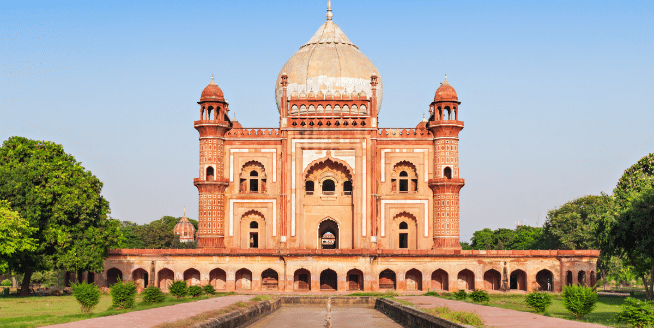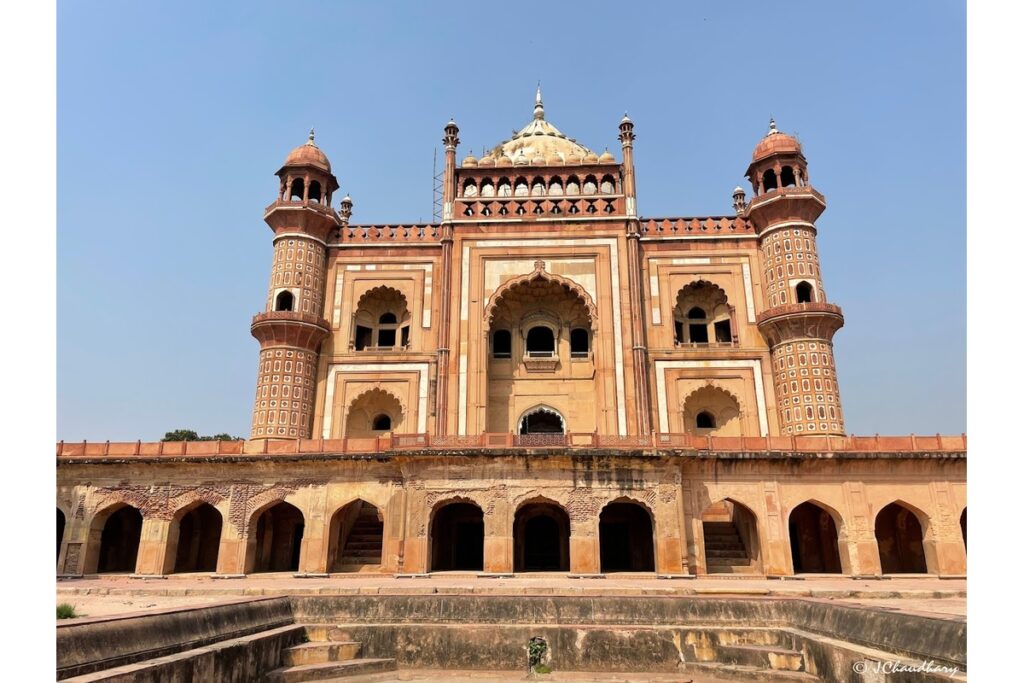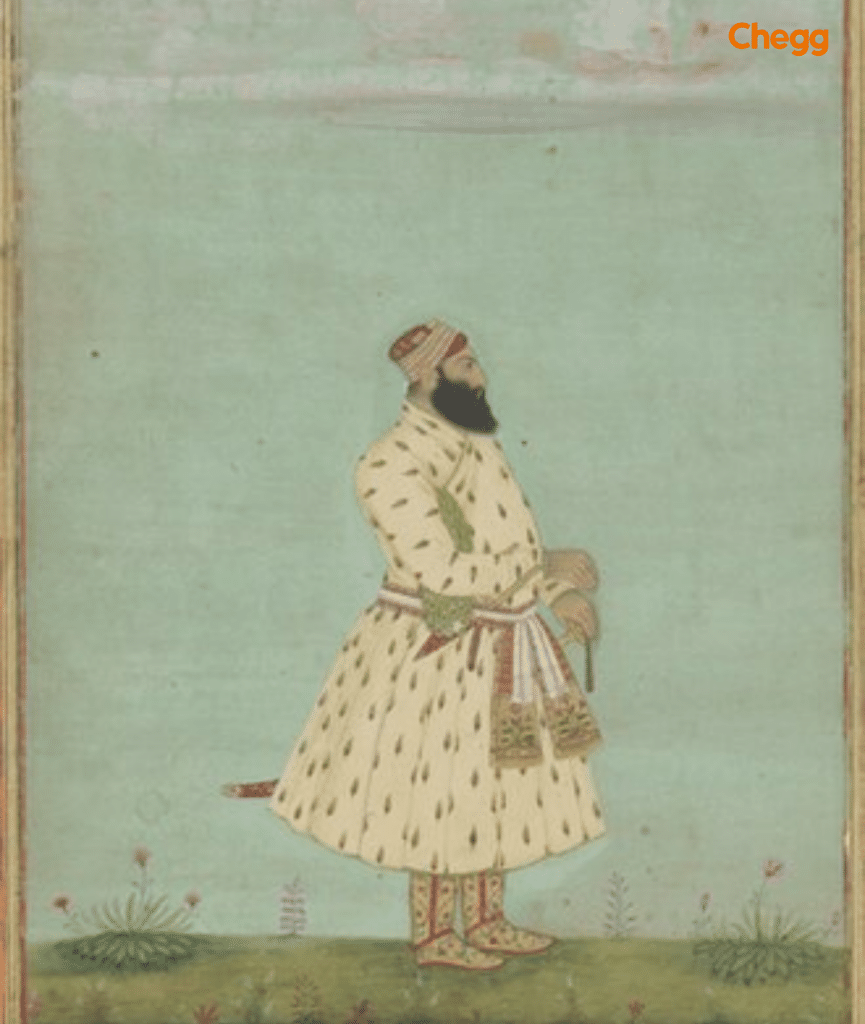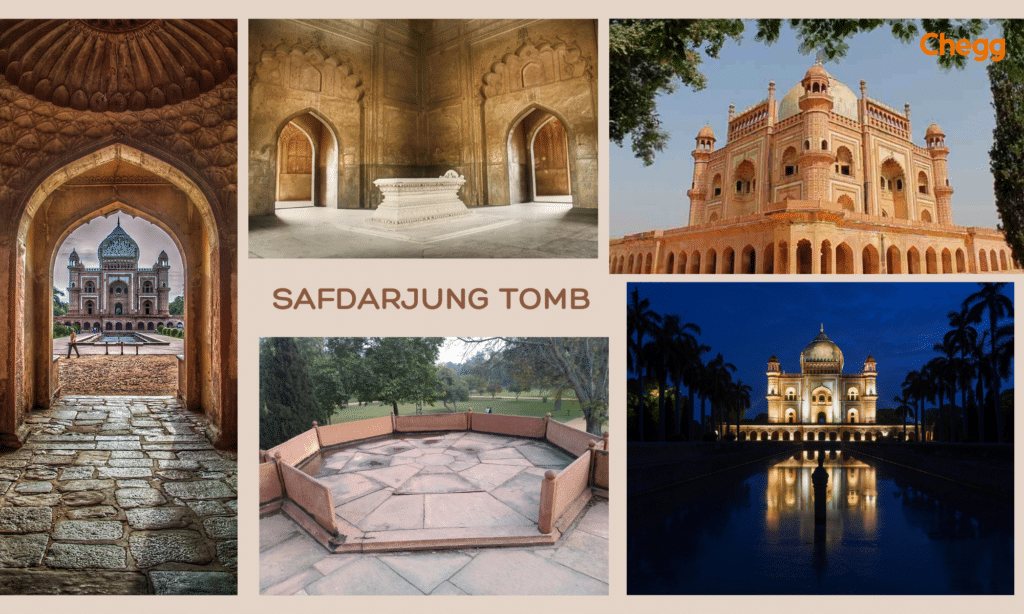
Quick Summary
Table of Contents
The Safdarjung Tomb is a grand Mughal-era mausoleum built in 1754 in Delhi as a remarkable testament to the legacy of Wazir-e-Mulk Nawab Safdarjung, the powerful second-in-command of the Mughal Empire. It is known for being the last monumental tomb garden of the Mughals. This majestic tomb captures the elegance of Mughal architecture while honoring Safdarjung’s vital role and contributions during the reign of Emperor Muhammad Shah.

As you explore the tomb’s intricate design and lush surroundings, you’ll uncover the story of Safdarjung’s endurance, leadership, and influence, immortalized in one of Delhi’s most iconic historical monuments. Safdarjung Tomb symbolizes Mughal grandeur and the final resting place of a remarkable leader whose impact shaped the empire’s history.
During 1753-54, Nawab Shujaud Daula initiated the construction of the Safdarjung Tomb as a tribute to Safdarjung, who served as the Viceroy of Awadh under Mughal Emperor Mohammed Shah. Safdarjung, originally from Persia (modern-day Iran) and a descendant of Qara Yusuf from the Kara Koyunlu, was born Muhammad Muqim in Khurasan.
Upon arriving in India in 1722, he assumed the position of Subadar Nawab of Oudh, governing the Awadh state from March 19, 1739, until his passing. Emperor Nasir-ud Din Muhammad Shah gave him the’ Safdarjung’ title.
In 1748, after Ahmad Shah Bahadur became the new Mughal emperor, Safdarjung relocated to Delhi and became the Wazir ul-Mamalik-i-Hindustan or Prime Minister of Hindustan. However, in 1753, he returned to Awadh and died a year later in Sultanpur, near Faizabad. Subsequently, Mughal Emperor Ahmad Shah Bahadur authorized Safdarjung’s son, Nawab Shujaud Daula, to erect a mausoleum in Delhi to honor his father’s legacy.

The legacy of Nawab Safdarjung begins with the story of Saadat Khan. He was a personal nobleman who rose to an influential role in the Mughal court. Later in the dynasty, his son Safdarjung succeeded him, and people considered his presence in the court palace integral and ambitious.
People consider Nawab Safdarjung, born Abdul Mansur Mir Muhammad Muqim Ali Khan Shuja-ud-doula, a descendant of Qara Yusuf from the Kara Koynlu. In 1722, he marked his journey to India and embarked on a fresh chapter in the Mughal dynasty.
Nawab Safdarjung’s influence grew steadily in the Mughal Empire. He became the Subadar Nawab of Oudh and ruled over the state of Awadh province. His power and influence have ensured his secure position throughout his lifetime. His dedication and loyalty towards the Mughal emperor Nasir-ud-Din Muhammad Shah earned him the reputable title of Safdarjung.
Even though it has enhanced its significance in the Mughal court, it doesn’t remain the same.
After Muhammad Shah’s death, the throne passed to Ahmad Shah Bahadur. They once again tested Nawab Safdarjung’s power and loyalty. They relocated him to Delhi and appointed him as Wazir ul-Mamalik-i-Hindusta, the prime minister. His impeccable journey from being a mere Persian native to a powerful statement in the Mughal court proved his political acumen.
His era with the Mughal empire ended in 1753, and it marked his return to Oudh. He died on October 5, 1754, in Sultanpur, near Faizabad.
Safdarjung Tomb is one of New Delhi, India’s most essential and iconic Mughal-era monuments. Though not as famous as the Taj Mahal or Humayun’s Tomb, it holds immense historical and architectural significance. Let’s dive deeper into its location and importance:
1. Historical Significance:
2. Architectural Significance:
3. Cultural and Symbolic Importance:
4. Role as a Tourist Attraction:
5. Fun Facts About Safdarjung Tomb:
The Safdarjung Tomb is a crucial monument in New Delhi, providing insight into the later years of the Mughal Empire and the rise of regional powers. Its location in the heart of the city makes it easily accessible, while its architectural significance showcases the splendor of Mughal design. Safdarjung Tomb remains an essential part of India’s rich history, symbolizing the power and culture of the Mughal era and the changing political landscape of 18th-century India. Whether you are a history enthusiast or someone looking to explore the beauty of Mughal architecture, the Safdarjung Tomb is a must-visit landmark in Delhi.

The architecture of Safdarjung’s tomb perfectly blends Persian and Mughal styles, exposing the intricate craftsmanship and keen attention to detail. High arches, ornate domes, and delicate minute stands symbolize the iconic Mughal style, similar to the landmarks, including the Taj Mahal. The detailing on the façade and the use of red and marble sandstone labeled with formula mortise give you an inspiring visual spectacle.
Builders constructed the Safdarjung Tomb in parallel with the great Humayun’s Tomb. They carved the central mausoleum with a luscious garden, serving as a reminiscence of the alluring Charbagh layout. A courtyard garden encompasses the majestic monument, extending around 280 meters per side. Water features divide it into four quadrants, signifying the Islamic tradition. As you stroll towards the pathway, it transports you to the elegant era of the Mughal Empire.
The surroundings of the Safdarjung Tomb feature a captivating garden divided into four small square patches, mirroring the typical layout of Mughal gardens. Designed in the Mughal tradition, this garden enhances the allure of the tomb complex with its lush greenery and vibrant blossoms, fostering a tranquil ambiance for visitors to relish.
Water channels within the garden contribute to its enchanting appeal, offering a soothing accompaniment to visitors’ explorations. Adorned with a grand entrance gate crafted from red sandstone, boasting two stories with arched openings, the garden serves as a picturesque pathway leading to the tomb. Inside the tomb’s interior, housing Safdarjung’s cenotaph, exudes a mysterious yet serene aura, showcasing the exquisite craftsmanship of Mughal architecture.
The garden invites leisurely strolls, providing an idyllic setting for both sightseeing and photography enthusiasts, elevating the magnificence of this renowned mausoleum and cementing its status as a premier attraction in Delhi.
Safdarjung’s Tomb, constructed in 1754, commemorates the life and legacy of Safdarjung, the Prime Minister of the Mughal Empire under Emperor Muhammad Shah. This magnificent mausoleum, located in New Delhi, stands as a fusion of Mughal and Persian architectural styles, showcasing intricate carvings, a grand dome, and expansive gardens.
Designed by Nawab Shuja-ud-Daula, Safdarjung’s Tomb is reminiscent of the famed Humayun’s Tomb, contributing significantly to Delhi’s architectural landscape. Historically, it marks the zenith of the Mughal Empire’s decline and the emergence of regional powers in India. Beyond its historical significance, the tomb serves as a symbol of Safdarjung’s influence and architectural prowess, drawing admirers worldwide to marvel at its grandeur and beauty.
Read More:-
Safdarjugn was a prominent figure in the political scenario of the Mughal Empire. He took control of every power, which left the new Mughal emperor with no real decision-making authority. His over-controlling behavior paved the way for the Marathas to drive him out of Delhi.
The Arabic inscription in the Safdarjung tomb has an intriguing inscription: ‘ When the hero of plain bravery departs from the transitory, may he become a resident of god’s paradise’. The quote indicates the bravery and influence of Nawab Safdarjung in the Mughal court.
Updates on Safdarjung Tomb:
| Attraction | Distance from Safdarjung Tomb | Highlights |
|---|---|---|
| Lodhi Gardens | 1 km | The world’s tallest brick minaret, an Indo-Islamic architectural, UNESCO World Heritage site. |
| Humayun’s Tomb | 3 km | UNESCO site, stunning Mughal architecture, symmetrical gardens. |
| Qutub Minar | 8 km | Iconic war memorial, a popular evening spot, beautifully lit at night. |
| India Gate | 4 km | India’s largest museum has, vast collection of historical artifacts spanning 5,000+ years. |
| Khan Market | 2.5 km | Shopping and dining hub, high-end stores, cafes, and boutiques. |
| National Museum | 5 km | The world’s tallest brick minaret, an Indo-Islamic architectural site, UNESCO World Heritage site. |
Safdarjung’s Tomb, a magnificent architectural marvel, holds many intriguing facts:
A visit to Safdarjung’s Tomb offers a glimpse into the grandeur and sophistication of the Mughal era.
Even though not well-recognized, the Safdarjung tomb is the authentic marker of the Mughal phase in Indian history. It stands true to the architectural inspiration and its cultural connection. It reflects the great era in Indian history from the beginning till the fall.
Walking through the corridors of Safdarjung’s tomb, apart from the serene gardens, you will observe the essence of the remarkable era and intricate architecture. In the path of classic architecture, the Safdarjung tomb will be a memorable chapter, paving the way for the beginning of a new age in the glorious history of India.
The Safdarjung Tomb was constructed between 1753 and 1754 as a mausoleum for Safdarjung, who served as Mohammed Shah’s viceroy of Awadh. Nawab Shujaud Daula, his son, constructed it.
Indian citizens must pay an entrance fee of Rs. 15, while foreign visitors must pay Rs. 300. Taking pictures inside is free of charge, but recording requires a small price of Rs. 25.
Although much smaller in scope than Humayun’s monument, Safdarjung’s Tomb is the final enclosed garden monument in Delhi. Constructed between 1753 and 1754, the mausoleum belonged to Safdarjung, the viceroy of Awadh under Mohammed Shah, the Mughal Emperor.
Nawab Shujaud Daula constructed the Safdarjung Tomb between 1753 and 1754. Constructed during Mohammed Shah’s reign as the Mughal emperor, Safdarjung served as the Viceroy of Awadh. Persia, or what is now Iran, was the homeland of Safdarjung.
Safdarjung Tomb is famous for its grand Mughal architecture, intricate charbagh garden layout, and historical significance as the last monumental tomb of the Mughal era. Built in 1754, it serves as the mausoleum of Safdarjung, the Prime Minister under Emperor Ahmad Shah Bahadur. The tomb is admired for its majestic dome, ornate gateway, and Persian-inspired aesthetics, making it a prominent heritage site in New Delhi.
No, Safdarjung Tomb has an entry fee. Indian citizens, SAARC visitors, and children may get discounted rates. Tickets can be purchased on-site or via the ASI website. The tomb is open daily from sunrise to sunset. Always check the latest fee and timings before visiting.
It is considered the last monumental garden tomb of the Mughal era and marked a declining phase in their architectural prowess. Built by his son, Nawab Shuja-ud-Daula, it’s the only major tomb built by a non-royal official during Mughal rule.

Authored by, Muskan Gupta
Content Curator
Muskan believes learning should feel like an adventure, not a chore. With years of experience in content creation and strategy, she specializes in educational topics, online earning opportunities, and general knowledge. She enjoys sharing her insights through blogs and articles that inform and inspire her readers. When she’s not writing, you’ll likely find her hopping between bookstores and bakeries, always in search of her next favorite read or treat.
Editor's Recommendations
Chegg India does not ask for money to offer any opportunity with the company. We request you to be vigilant before sharing your personal and financial information with any third party. Beware of fraudulent activities claiming affiliation with our company and promising monetary rewards or benefits. Chegg India shall not be responsible for any losses resulting from such activities.
Chegg India does not ask for money to offer any opportunity with the company. We request you to be vigilant before sharing your personal and financial information with any third party. Beware of fraudulent activities claiming affiliation with our company and promising monetary rewards or benefits. Chegg India shall not be responsible for any losses resulting from such activities.